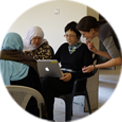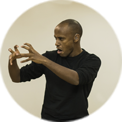Mind, Body, and Linguistic Form
Wendy Sandler
University of Haifa
The first half century of linguistic research on sign languages sought in these languages the same essential properties that characterize spoken languages. This enterprise was successful, and the similarities, including formal similarities, between languages in the two modalities, are indeed striking and often surprising. These results seemed to support the Chomskyan view that it is a computational system in the brain that determines linguistic structure, independent of the ‘sensorimotor system’ – i.e, independent of the body, which is considered secondary.
My goal here is to bring evidence from sign language in favor of a paradigm that works in the opposite direction, from thought units to the body, and from there to linguistic form. I show that this core thought unit, typically corresponding to a prosodic phrase, accrues linguistic form by the exigencies of the human body through communication over time. The evidence comes from (1) “modality effects” such as iconicity/arbitrariness and simultaneity/linearity, (2) the emergence of sign language from scratch, and (3) comparison of prosodic phrases and their content across modalities and across generations in language emergence. ‘Modality effects’, determined by the body, are not peripheral, but rather are critical to the structuring of language in both modalities.







